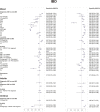Diagnostic Utility of Non-invasive Tests for Inflammatory Bowel Disease: An Umbrella Review
- PMID: 35911403
- PMCID: PMC9337241
- DOI: 10.3389/fmed.2022.920732
Diagnostic Utility of Non-invasive Tests for Inflammatory Bowel Disease: An Umbrella Review
Abstract
Background: This study aims to consolidate evidence from published systematic reviews and meta-analyses evaluating the diagnostic performances of non-invasive tests for inflammatory bowel disease (IBD) in various clinical conditions and age groups.
Methods: Two independent reviewers systematically identified and appraised systematic reviews and meta-analyses assessing the diagnostic utility of non-invasive tests for IBD. Each association was categorized as adults, children, and mixed population, based on the age ranges of patients included in the primary studies. We classified clinical scenarios into diagnosis, activity assessment, and predicting recurrence.
Results: In total, 106 assessments from 43 reviews were included, with 17 non-invasive tests. Fecal calprotectin (FC) and fecal lactoferrin (FL) were the most sensitive for distinguishing IBD from non-IBD. However, anti-neutrophil cytoplasmic antibodies (ANCA) and FL were the most specific for it. FC and FL were the most sensitive and specific tests, respectively, to distinguish IBD from irritable bowel syndrome (IBS). Anti-Saccharomyces cerevisiae antibodies (ASCA), IgA, were the best test to distinguish Crohn's disease (CD) from ulcerative colitis (UC). Interferon-γ release assay was the best test to distinguish CD from intestinal tuberculosis (ITB). Ultrasound (US) and magnetic resonance enterography (MRE) were both sensitive and specific for disease activity, along with the high sensitivity of FC. Small intestine contrast ultrasonography (SICUS) had the highest sensitivity, and FC had the highest specificity for operative CD recurrence.
Conclusion: In this umbrella review, we summarized the diagnostic performance of non-invasive tests for IBD in various clinical conditions and age groups. Clinicians can use the suggested non-invasive test depending on the appropriate clinical situation in IBD patients.
Keywords: Crohn’s disease; diagnostic performance; inflammatory bowel disease; non-invasive tests; ulcerative colitis.
Copyright © 2022 Shi, Zhang, She, Goyal, Wu and Xu.
Conflict of interest statement
The authors declare that the research was conducted in the absence of any commercial or financial relationships that could be construed as a potential conflict of interest.
Figures



References
-
- Buisson A, Gonzalez F, Poullenot F, Nancey S, Sollellis E, Fumery M, et al. Comparative acceptability and perceived clinical utility of monitoring tools: a nationwide survey of patients with inflammatory bowel disease. Inflamm Bowel Dis. (2017) 23:1425–33. 10.1097/MIB.0000000000001140 - DOI - PubMed
Publication types
LinkOut - more resources
Full Text Sources
Miscellaneous

